Answer Podcast
The post Isn’t the Gita’s instruction to remain equipoised seem too idealistic? appeared first on The Spiritual Scientist.
Websites from the ISKCON Universe
Answer Podcast
The post Isn’t the Gita’s instruction to remain equipoised seem too idealistic? appeared first on The Spiritual Scientist.
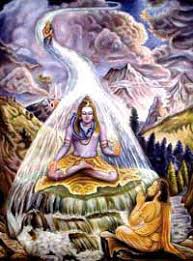
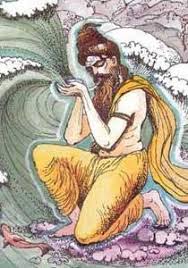
Maharaj Bhagiratha had, after great penances, been successful in bringing the most purifying Mother Ganges, whose waters wash the lotus feet of the Lord and are therefore his charanamrita, from the heavenly planets to this earth for the purpose of delivering his forefathers. While he was making the way from the Himalayas to the ocean for her to flow, he happened to pass by the hermitage of the great sage Jahnu.
Seeing the great river coming in his ashram and disturbing his meditation greatly enraged the pious sage, and in his anger, he swallowed all the water of the river. When Bhagiratha realised that mother Ganges was no longer following him and had been swallowed by the hermit, he immediately fell at the lotus feet of the sage, begging him to release Ganga. She was the only means of delivering his forefathers and her presence was for the benefit of the entire human race.
As is the nature of all the devotees of the Lord, Jahnu muni was naturally very compassionate and therefore he agreed to release mother Ganga, and he did so by expelling her waters from his right ear. Due to having been thus swallowed by Jahnu muni, Srimati Ganga devi came to be known as Jahnavi, the daughter of the Sage Jahnu.
It was on this auspicious 7th day of the Shukla paksha in the month of Vaisakh that this pastime of the Lord’s devotees took place and therefore this day is famous as Jahnu Saptami. This pastime actually came to take place in Sri Navadwip mandal at Jahnudvip, where Jahnu muni was absorbed in deep meditation upon Gaurahari and it was here that he was also blessed with the darshana of Mahaprabhu.
On this auspicious day, knowing mother Ganges to be very dear to Sri Caitanya Mahaprabhu, the devotees offer respects and perform puja to Srimati Ganga devi to get her mercy and the mercy of Jahnu muni. In this way they may also be able to some day serve in the pastimes of Sri Gaurahari.
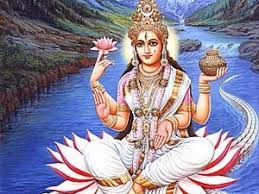
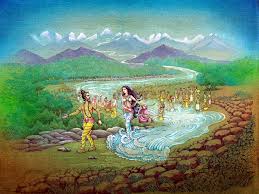

(Kadamba Kanana Swami, 23 August 2019, Ljubljana, Slovenia, Janmashtami Lecture)
When we feel that we have no taste for chanting and when we think to ourselves, “Oh I have no desire to chant sixteen rounds… it is taking such a long time and it is appearing to me as boring“, this is because we have no remembrance of Krsna. However, it is so easy to remember Krsna through His pastimes, because they are filled with rasa, with taste. They are not boring at all; they are actually full of excitement.
Are we religious? No, we are not religious. We are attracted to the pastimes of Krsna; as simple as that. It is this attraction and remembrance of the pastimes of Krsna that will give us the strength in chanting the Hare Krsna mahamantra. The reason for why we are not developing the taste for chanting is because we do not remember Krsna’s pastimes. So what we must do is just get fully absorbed in Krsna’s qualities, His pastimes, His nature and so on. We must focus to realize the kindness of Krsna and His mercy until we become captured by it. It is only when it captures us that we begin to chant with taste. If we do it as an exercise, we may struggle with it, but then we start to think about Krsna’s pastimes and suddenly our rounds move along. So it is really all about getting absorbed in remembering how amazing Krsna is. It is about being captured by His qualities and then we can chant the Hare Krsna mahamantra in ecstasy. That is what it is all about in the end, getting absorbed.
The article " Developing strength in chanting " was published on KKSBlog.
Mayapur head Pujaris HG Jananivas Prabhu & HG Pankajanghri Pr remembers how Sri Radha -Madhava boat festival celebrated in Mayapur in the past and also on the arrangements made for this year’s boat festival in the temple.
The post Jananivas Pr & Pankajanghri Pr speaks on Boat Festival appeared first on Mayapur.com.
Answer Podcast
The post How can we become more contemplative in daily life? appeared first on The Spiritual Scientist.

With ISKCON book distributors off the streets and staying at home due to the Coronavirus pandemic, you might think their service has completely ground to a halt. Instead, however, they’ve put all their energy into innovations such as mailing, contactless delivery, and e-books to distribute thousands of Prabhupada’s books at a time when people need them more than ever.
Answer Podcast
The post Even when cows are cared for, still during reproduction aren’t bulls essentially allowed to rape the cows? appeared first on The Spiritual Scientist.
Recently we launched the Second Annual #GivingTOVP 10 Day Matching Fundraiser. This event started on April 26 (Akshaya Tritiya) and continues until May 6 (Nrsimha Caturdasi) and is poised to raise over $300,000 to help the completion of Lord Nrsimha’s entire East Wing and altar in the TOVP for the opening ceremony during Gaur Purnima 2021.
In this video TOVP Director of Development, His Grace Braja Vilasa prabhu speaks about the importance of this fundraiser for completing Lord Nrsimha’s temple wing and altar by 2021.
Due to the disastrous effects of the Coronavirus pandemic worldwide and the 21 day lock-down in India, ISKCON Mayapur is experiencing a serious financial crisis. On account of this emergency situation, Ambarisa and Braja Vilasa prabhus from the TOVP have decided to help ISKCON Mayapur by creating an extension campaign to the #GivingTOVP Fundraiser called the TOVP Care Emergency Matching Fund Campaign. Ambarisa will match 10 cents for every dollar raised for the #GivingTOVP Fundraiser (online only) and donate it to ISKCON Mayapur.
For more information go here.
Please download and share the #GivingTOVP Fundraiser flyer below.
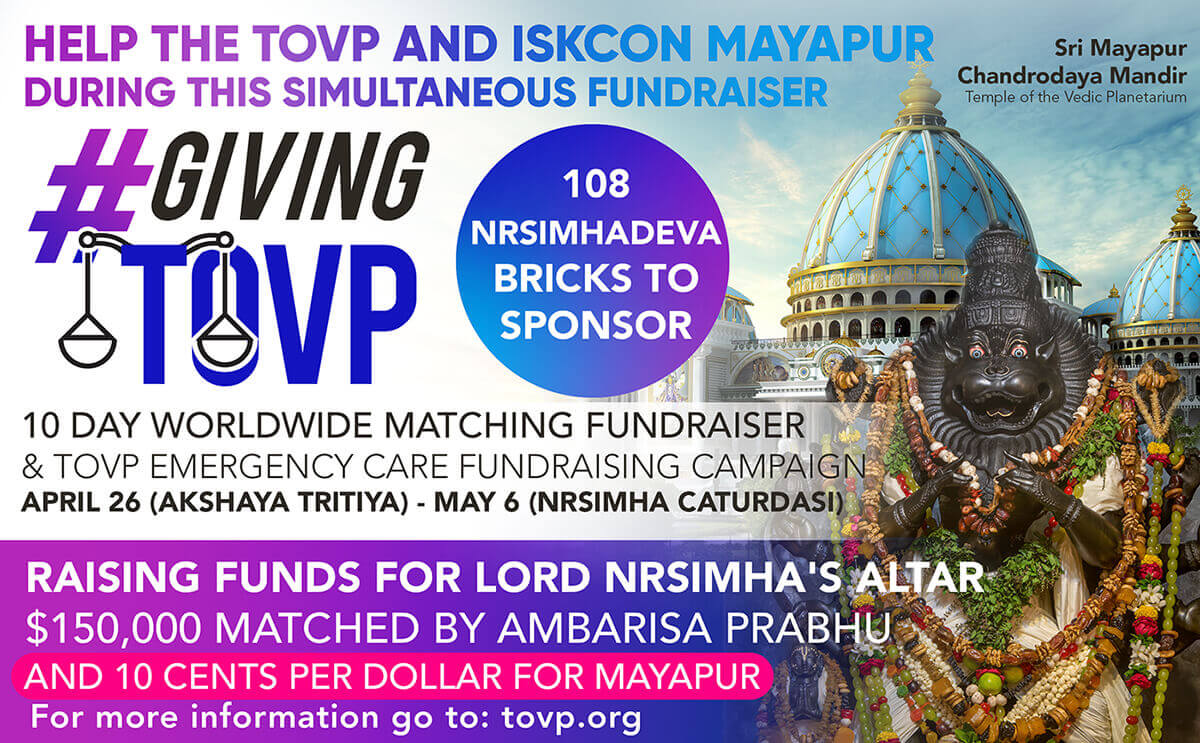
Visit us at: www.tovp.org
Follow us at: www.facebook.com/tovp.mayapur
Watch us at: www.youtube.com/user/tovpinfo
View us 360° at: www.tovp360.org
App at: https://m.tovp.org/app
News & Texts at: https://m.tovp.org/newstexts
RSS News Feed at: https://tovp.org/rss2/
Buy from us at: https://tovp.org/tovp-gift-store/
Support us at: https://tovp.org/donate/seva-opportunities/
The post H.G. Braja Vilas Prabhu Speaks About the #GivingTOVP 10 Day Matching Fundraiser appeared first on Temple of the Vedic Planetarium.
Answer Podcast
The post If we can’t move to eco-friendly farms, what can we do practically to live more eco-friendly? appeared first on The Spiritual Scientist.
Answer Podcast
The post If we take milk from dairy farms, do we get the karma? appeared first on The Spiritual Scientist.
HH Bhakti Purusottama Swami distributed today Prasada to villagers. Around 10,000 plates distributed to nearby villages. Akshaya Tritiya Food for Life Program HH Bhakti Purusottama Swami distributing Prasad today for villagers Video Posted by Mayapur.com on Sunday, April 26, 2020 Prasada Distibution Photo Gallery
The post Akshaya Tritiya Prasada Distribution appeared first on Mayapur.com.
 The day known as Aksaya-tritiya occurs on the third (tritiya) day of the waxing moon in the month of Vaisakha. Every second of this blessed day is completely auspicious, and so there is no consideration of any one period (muhurta) being better than another. Aksaya means “inexhaustible”; anything a person undertakes on the day of Aksaya-tritiya is bound to succeed, especially the performance of devotional activities, which guarantee inexhaustible benefit.
The day known as Aksaya-tritiya occurs on the third (tritiya) day of the waxing moon in the month of Vaisakha. Every second of this blessed day is completely auspicious, and so there is no consideration of any one period (muhurta) being better than another. Aksaya means “inexhaustible”; anything a person undertakes on the day of Aksaya-tritiya is bound to succeed, especially the performance of devotional activities, which guarantee inexhaustible benefit.
It is said that Aksaya-tritiya is the day when Treta-yuga began and the river Ganges descended to earth. Also, the festival known as Candana-yatra starts on the Aksaya-tritiya.
In the Madhva-sampradaya, Aksaya-tritiya is celebrated as the day of the incarnation of Lord Vishnu as Parasurama. In the Sri Krishna Mutt monastery a special festival takes place during which the aksaya-patra, the marvelous pot gifted by the sun god to Draupadi, is worshiped. Srimati Draupadi was given the benediction that her pot would provide unlimited food at each meal, until she herself ate from it. It appears that the pot came under the custody of Sri Madhvacharya, and on Aksaya-tritiya it is worshiped and prasada is lavishly distributed throughout the day.
In Nandagrama, where Sri Krishna enjoyed his childhood pastimes with Nanda Maharaja and Mother Yasoda, an interesting incident took place on Aksaya-tritiya. When Nanda Maharaja established his residence in Nandagrama, he excavated a large lake, then known as Nanda Sarovara. Nanda Maharaja, his family members, and all the Vraja-vasis used to bathe in that lake. And it is said that while Nanda Maharaja and his family bathed at one end of the lake, Vrsabhanu Maharaja would occasionally come and bathe with his family at the other end. According to local tradition, Srimati Radharani and Krishna used to swim underwater to the middle of the lake and engage in pastimes.
One day, little Krishna noticed that instead of cooking the usual meal of rice, dal, subji, and chapatis, Mother Yasoda was making all kinds of fried preparations with dal, noodles, and flour. When Krishna asked her why she was cooking those things, she replied that Nanda Maharaja was going on a pilgrimage the next day and that the fried things she was cooking would last for several days without spoiling.
Krishna then asked where His father was going, and Mother Yasoda replied that he was going to Prayaga. Little Krishna went to Nanda Maharaja and asked him where Prayaga was and why he was going there. Nanda Maharaja explained that Prayaga is the most sacred place where the three rivers Ganga, Yamuna, and Sarasvati meet and flow together and that to take bath there was most auspicious.
The next morning was the Aksaya-tritiya, the perfect day to start on a long journey. As usual, Nanda Maharaja got up early and went to take bath in his lake. When he got there, he saw a man he had never seen before, an imposing, regal person, rolling in the dust. While rolling in the dust, the man laughed loudly. Every now and then he would get up and dive into Nanda Sarovara, and then again he would come out and roll in the dust and laugh, and again bathe in the lake.
Nanda Maharaja approached the kingly man and asked, “Maharaja, who are you?”
“Baba, I’m Prayaga,” the man replied.
“Prayaga? I don’t know anyone in Nandagrama with that name.”
“No, no. I’m not from here. I’m Prayaga Raja, the king of all the holy places (tirthas)!”
“And why have you come here today, Maharaja?”
“Baba, all year long people come and bathe in my waters and leave their sins. So, every year, on Aksaya Tritiya, I come here, roll in the dust of Vraja, and bathe in this sarovara, because this dust and this lake have the potency to purify (pavana) one from all sins.”
Nanda Maharaja was amazed. Suddenly, he noticed that on the other side of the lake were many beautiful ladies in silk saris embroidered with gold and silver threads. They were also bathing in the lake. Approaching them respectfully, Nanda Maharaja asked who they were.
One lady replied, “Baba, I’m Ganga.” Another said, “I’m Sarasvati.” And yet another said, “I’m Godavari.” They all responded with the names of different holy rivers: Kurujangala, Kaveri, Narmada, Brahmaputra, Mahananda, etc.
Then Nanda Maharaja asked, “And why have you come here today? I’ve never seen you before.” The ladies explained that all year long people put their sins within their waters and that every year on the Aksaya Tritiya day they came to Vraja to roll in its dust, bathe in the sarovara, and become purified (pavana).
After taking his bath, Nanda Maharaja went back up the hill to his residence. By that time little Krishna was awake. Coming before his father, he asked, “Baba, are you going now?” “No, Lala. I’m not going.” “Why, Baba?” “Because today, all the places I wanted to go came to take bath in our lake and become purified (pavana). So why should I take the trouble to go to them when they all came here?”
From that day, Nanda Sarovara became known as Pavana Sarovara.
At no other time in modern history has the protection of the Supreme Personality of Godhead for His devotees been needed as now. Due to the worldwide Corona virus pandemic temples have been shut down, projects have come to a standstill, Harinam sankirtana has stopped, book distribution has halted, and so much more. And, even more disturbing is devotees have unfortunately passed away. This is all lamentable and out of anyone’s control. In such a situation we can only call on the Lord for help.
Lord Nrsimha is the protector of the devotees and the destroyer of evil and darkness. He is also very favorable to the devotees of the sankirtan movement of Lord Caitanya because their lives are dedicated to preaching His divine name and glories throughout the world at all costs. And of all the deities of Lord Nrsimha, Ugra Nrsimha in Mayapur is the most worshipable and favorite in ISKCON. Recently, we started a daily Nrsimha yajna for the protection of devotees worldwide and received over 6,000 participant names to read to the Lord each day.
On May 5, the day before Nrsimha Caturdasi, the TOVP management has decided to perform a special Maha Yajna and Japa Yajna for the benefit of devotees worldwide as a service to and in gratitude for everyone’s seva to the TOVP, and for the benefit of humanity in general. To participate we are requesting every devotee to register on the TOVP App and provide us with their name and the names of immediate family members to be read to the Lord during the yajna, and to commit to chanting extra rounds of japa daily. Each devotee that provides these names will receive by mail an offered Nrsimha Raksha Sutra wrist thread as prasadam for each family member (Please note that this is contingent on the re-opening of major shipping services throughout the world). Below is an explanation for how to provide us with your names.
To download the TOVP App select one of the following links:
Once you complete the registration process click on the App Menu at the top left corner of the page (three small lines). Under NEWS you will see the option to register for the Nrsimha Maha Yajna. Please fill out and provide all the details requested on the Registration Form.
Open your TOVP App. You may be requested to update the App upon opening. Once that is done click on the App Menu at the top left corner of the page (three small lines). Under NEWS you will see the option to register for the Nrsimha Maha Yajna. Please fill out and provide all the details requested on the Registration Form.
Hare Krishna and please be safe and healthy. We pray to the Lord for His blessings upon you and hope to be of some small service to you and your family through this Maha Yajna event.
Visit us at: www.tovp.org
Follow us at: www.facebook.com/tovp.mayapur
Watch us at: www.youtube.com/user/tovpinfo
View us 360° at: www.tovp360.org
App at: https://m.tovp.org/app
News & Texts at: https://m.tovp.org/newstexts
RSS News Feed at: https://tovp.org/rss2/
Buy from us at: https://tovp.org/tovp-gift-store/
Support us at: https://tovp.org/donate/seva-opportunities/
The post TOVP Nrsimha Caturdasi Maha Yajna and Japa Yajna – May 5, 2020 appeared first on Temple of the Vedic Planetarium.
This Video shows a glimpse of ISKCON Mayapur’s Food for Life Program in the villages as a part of Covid-19 relief works. We thank all the donors for their support and kindness! Spread this good word to all your contacts and let everyone receive the spiritual benefit of serving Sridham Mayapur!
The post ISKCON Mayapur Food for Life Video ! appeared first on Mayapur.com.
Recently we sent out the official announcement about the Second Annual #GivingTOVP 10 Day Matching Fundraiser which you can read here. This event starts on April 26 (Akshaya Tritiya) until May 6 (Nrsimha Caturdasi) and is poised to raise over $300,000 to help the completion of Lord Nrsimha’s entire East Wing and altar in the TOVP for the opening ceremony during Gaur Purnima 2021.
In this video His Holiness Lokanath Swami speaks about the importance of this fundraiser for completing Lord Nrsimha’s temple wing and altar by 2021.
Due to the disastrous effects of the Corona virus pandemic worldwide and the 21 day lock-down in India, ISKCON Mayapur is experiencing a serious financial crisis. On account of this emergency situation, Ambarisa and Braja Vilasa prabhus from the TOVP have decided to help ISKCON Mayapur by creating an extension campaign to the #GivingTOVP Fundraiser called the TOVP Care Emergency Matching Fund Campaign. Ambarisa will match 10 cents for every dollar raised for the #GivingTOVP Fundraiser (online only) and donate it to ISKCON Mayapur.
For more information go here.
Please download and share the #GivingTOVP Fundraiser flyer below.

Visit us at: www.tovp.org
Follow us at: www.facebook.com/tovp.mayapur
Watch us at: www.youtube.com/user/tovpinfo
View us 360° at: www.tovp360.org
App at: https://m.tovp.org/app
News & Texts at: https://m.tovp.org/newstexts
RSS News Feed at: https://tovp.org/rss2/
Buy from us at: https://tovp.org/tovp-gift-store/
Support us at: https://tovp.org/donate/seva-opportunities/
The post H.H. Lokanath Swami Speaks About the #GivingTOVP 10 Day Matching Fundraiser appeared first on Temple of the Vedic Planetarium.
Akshaya Tritiya in essence is the day of Receiving – the day to receive unlimited spiritual benefit by giving, expecially offering charity on Akshaya Tritiya is considered very virtuous . Scriptures proclaim that offering oblations to forefathers, taking bath in holy river, offering anna dana, sastra dana brings one more auspiciousness than given on any […]
The post Celebrate the Day of Receiving – Akshaya Tritiya! appeared first on Mayapur.com.
From Anuj Agarwal
Is it mentioned somewhere in the Gita?
Transcription :
Transcriber: Sharan Shetty
Edited by: Keshavgopal Das
Question: What is the difference between a jnani and jnana-yogi?
Answer: Jnani refers specifically to a person who possesses knowledge. Jnana yogi refers to a person who is following the process of jnana yoga which is one of the yoga within the Vedic tradition. This specific difference is not mentioned in the Bhagavad-gita because it is a philosophical book and not a lexicological book. It is not a dictionary which gives meaning of words and technically differentiate between the words. However, Bhagavad-gita does talk about these concepts broadly.
Jnana yoga is a particular kind of sadhana which focuses primarily on intellectual contemplation and by saying neti-neti (na iti, na iti or I am not this, not this). In other words, by saying no to matter, one understands the reality beyond matter.
In chapter 18 of the Bhagavad-gita, verse 49 to 53 roughly talks about the process of jnana yoga where there is detachment from the world, after which, the person comes to bhakti yoga (Verse 54 says brahma bhuta prasannatma and then there is labhate param – attains my bhakti). The acharyas generally explain that this section refers to jnana yoga. The word jnani is used by Lord Krishna in BG 7.17, tesam jnani nitya-yukta eka-bhaktir vishishyate (Of these, the one who is in full knowledge and who is always engaged in pure devotional service is the best).
Krishna has mentioned four kind of people who surrender to him in BG 7.16. In the very next verse (BG 7.17) Krishna is saying that among those four, jnani is special (vishishyate). Krishna is using the word jnani and is also subsequently describing his qualities – he is always engaged (nitya yukta) and one pointed in devotion (eka bhaktir). Such a person is special. Krishna is practically describing that although such a person may have come from the path of intellectual contemplation, but he is for all practical purpose, doing bhakti sadhana and so, he is one pointed in devotion. This jnani is not a jnana yogi but is a person who approaches Krishna with knowledge. He thinks, “There must be some reality beyond this world. I want to know what that reality is, I want to develop a relationship with that reality” and because of that, this jnani is free from material motives. That is why, connecting with Krishna becomes much swifter and easier. It is also much more pleasing to Krishna because this person is coming with a relatively selfless motive. The other three categories of people – artah (the distressed), artha-arthi (one who desires wealth) and jijnasuh (the inquisitive), they will become jnana-van or possessors of knowledge after some time as explained in BG 7.19 : bahunam janmanam ante jnanavan mam prapadyate meaning “After many births and deaths, he who is actually in knowledge surrenders unto Me”.
The word jnani is often used in a negative sense. Srila Jiva Goswami in his Bhakti sandarbhas and commentary of Bhakti rasamrita sindhu explains that there is good jnana and bad jnana (shushka jnana). Shushka jnana focuses on the oneness of the soul with the Supersoul but good jnana is that which focuses on the glories of Krishna and the difference between the soul and the Supersoul (the soul is tiny and Krishna is great). This jnana increases one’s devotion for Krishna.
Therefore, the word jnani is not a monopoly of the jnana yogis. Jnani is a generic term referring to those who have knowledge and bhaktas have the highest knowledge as the Chaitanya Caritamrita says, krishna yei bhaje sei bada catura – intelligent man is he who is Krishna Conscious. Also, according to Krishna, jnana-van (person who is in full knowledge) is who surrenders to him (BG 7.19 – jnanavan mam prapadyate) and those who become his devotees.
In that sense, jnana yogi refers to a seeker on a particular path, jnani refers to a person who has knowledge which can be from any path and the bhaktas are those with fullest knowledge.
End of transcription.
The post What is the difference between a jnani and jnani-yogi? appeared first on The Spiritual Scientist.
 Giriraj Swami read and spoke from Srimad Bhagavatam 7.9.19 while on a Zoom conference with devotees in Spain.
Giriraj Swami read and spoke from Srimad Bhagavatam 7.9.19 while on a Zoom conference with devotees in Spain.
“Through parental care, through remedies for different kinds of disease, and through means of protection on the water, in the air and on land, there is always an endeavor for relief from various kinds of suffering in the material world, but none of them are guaranteed measures for protection. They may be beneficial temporarily, but they afford no permanent benefit. Despite the presence of a father and mother, a child cannot be protected from accidental death, disease and various other miseries. No one can help, including the parents. Ultimately the shelter is the Lord, and one who takes shelter of the Lord is protected. This is guaranteed.” SB 7.9.19 purport.
Use this Time to go Deeper in Krishna Consciousness (Right click to download)